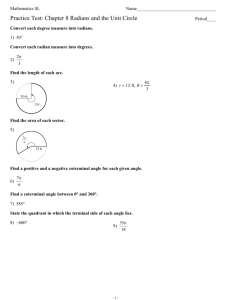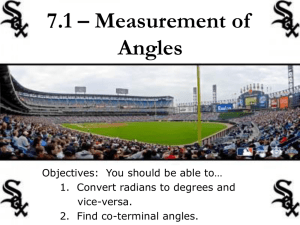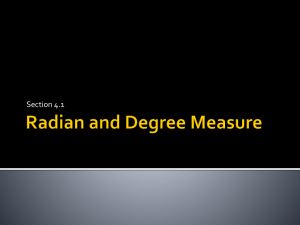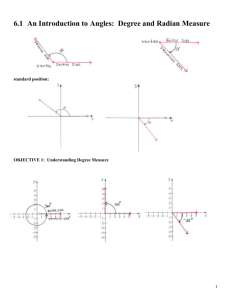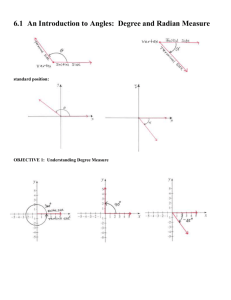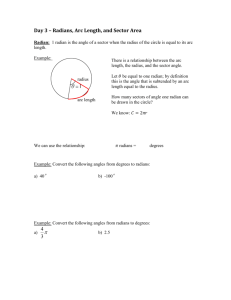13-2
advertisement
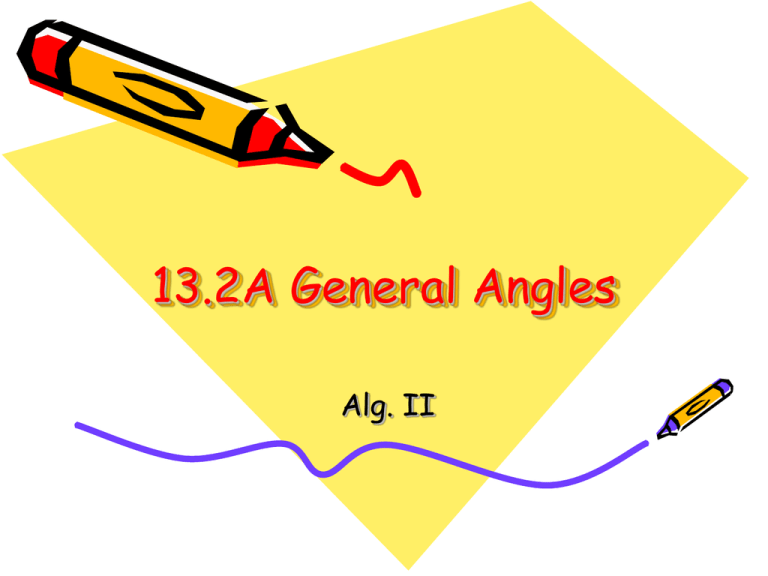
13.2A General Angles Alg. II Angles In Standard Position Recall: Angle- formed by two rays that have a common endpoint, called the vertex. Generated by… 1. Fixing one ray (the initial side) 2. Rotating the other ray (the terminal side) about the vertex Standard position-In a coordinate plane, an angle whose vertex is at the origin and whose initial side is the positive x-axis. Angles in Standard Position • Measure of an angle – Determined by amount and direction of rotation from the initial side to the terminal side. – Positive if the rotation is counterclockwise – Negative if the rotation is clockwise. (terminal side of an angle can make more than one full rotation) Angles in Standard Position Terminal side y 90° 0° x 180° vertex Initial side 270° 360° Drawing Angles in Standard Position Example 1Draw an angle with the given measure in standard position. Then tell in which quadrant the terminal side lies. a. -120 ° b. 400 ° Quadrant II Quadrant I -120 ° Quadrant IV Quadrant III Quadrant I 400 ° Finding Coterminal Angles • Two angles in standard position are coterminal if their terminal sides coincide (or match up). • Can be found by adding or subtracting multiples of 360 ° to the angle. Finding Coterminal Angles Example 2 – Find one positive and one negative angle that are coterminal with (a) -100 ° and (b) 575 ° a. Positive coterminal angle: -100 ° + 360 ° = 260 ° Negative coterminal angle: -100 ° - 360 ° = -460 ° b. Positive coterminal angle: 575 ° - 360 ° = 215 ° Negative coterminal angle: 575 ° - 720 ° = -145 ° Finding Coterminal Angles • Angles can also be measured in radians. Radians- the measure of an angle in standard position whose terminal side intercepts an arc length r. Circumference of circle = 2 π(r), meaning there are 2 π radians in a full circle. Also meaning (360 ° = 2 π radians) and (180 ° = π radians) 13.2B Conversions Between Degrees and Radians • Degree Measure in Radians – To rewrite, multiply by π radians 180° • Radian Measure in Degrees – To rewrite, multiply by 180° π radians . Converting Between Degrees and Radians Example 3 a. Convert 320 ° to radians. 16 π radians 9 b. Convert - 5 π 12 radians to degrees. -75 ° Arc Lengths & Areas of Sectors • Sector – a region of a circle that is bounded by two radii and an arc of the circle. • Central angle of a sector – the angle formed by two radii. Arc length s r 1 2 A r 2 Ex. 4 Find the arc length and area of sector • With radius of 5 centimeters and a central angle of 45 Ex. 5 Evaluate the trig function using a calc. • (Or tables on pg. 861 & 853) for sin 6
